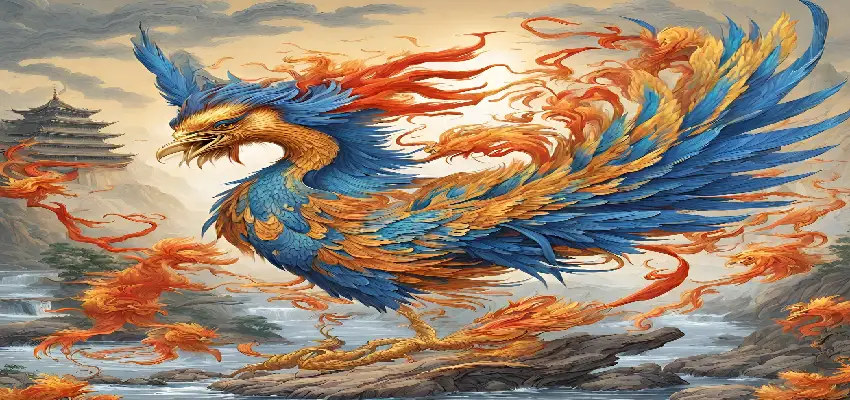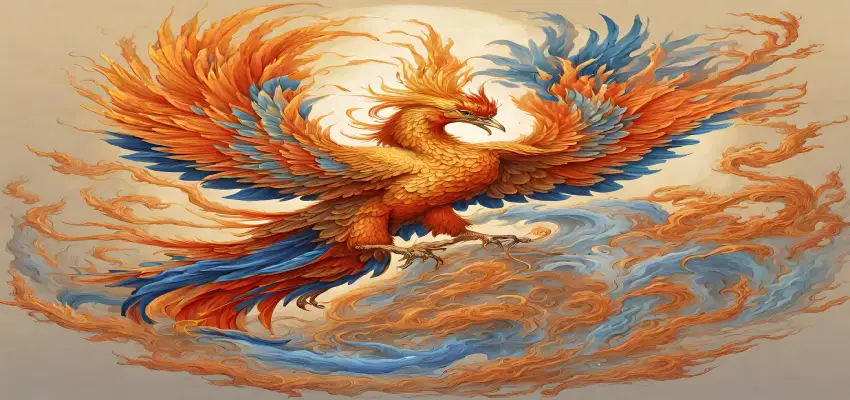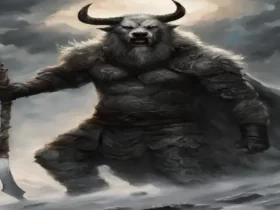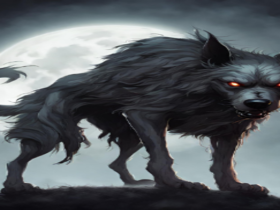The fènghuáng, known as 鳳凰 in Chinese (Jyutping: fung6 wong4; Cantonese Yale: fuhng wòhng, Mandarin pronunciation: [fə̂ŋ.xwǎŋ]), are mythical birds deeply rooted in Sinospheric mythology, holding dominion over all avian creatures. Originally, the males were designated as fèng, and the females as huáng, but contemporary interpretations often eschew this gender distinction, amalgamating them into a singular feminine entity. This fusion allows the fènghuáng to be paired with the Chinese dragon, a creature traditionally perceived as male.
This legendary avian entity is recognized by similar appellations in various languages, such as hōō in Japanese, phượng hoàng or phụng hoàng in Vietnamese, and bonghwang in Korean.
1Feng Huang Is Also Named As Chinese Phoenix

In Western parlance, it is commonly referred to as the Chinese phoenix or simply phoenix. However, it’s important to note that despite superficial mythological resemblances to the Western phoenix, the fènghuáng maintains distinct characteristics and symbolism within its cultural context.
2Feng Huang Is A Combination Of Different Birds Beyond Human Imagination

An often portrayed image of the fènghuáng illustrates it engaged in combat with serpents, using its talons and spreading its wings. Paintings and murals frequently depict Feng Huang engaged in battle with its natural adversary, the snake, emphasizing its mythical prowess.
The Erya’s 17th chapter, Shiniao, provides a detailed description, characterizing the fènghuáng as a composite creature with the beak of a rooster, the face of a swallow, the forehead of a fowl, the neck of a snake, the breast of a goose, the back of a tortoise, the hindquarters of a stag, and the tail of a fish.
In contemporary descriptions, however, the fènghuáng is frequently portrayed as a fusion of various bird species, incorporating elements such as the head of a golden pheasant, the body of a mandarin duck, the tail of a peacock, the legs of a crane, the mouth of a parrot, and the wings of a swallow. This transformation reflects a shift in the mythical representation of the fènghuáng over time.
Must Read: Minokawa (Philippine Mythology): A Bird Bigger Than An Island
3From Head To Tail, Each Body Part Of Feng Huang Represents A Different World

The symbolism of the fènghuáng extends to its anatomy, with each part representing celestial elements: the head signifies the sky, the eyes embody the sun, the back represents the moon, the wings symbolize the wind, the feet stand for the earth, and the tail embodies the planets. According to legend, the fènghuáng has its origins in the sun, and its physical form incorporates the essence of the five fundamental colors: black, white, red, yellow, and green. In various depictions, the fènghuáng is depicted carrying scrolls or a sacred book-filled box, and sometimes, it is portrayed with a luminous fireball.
4First Archaeological Evidence Of Feng Huang Can Be Found At The Gaomiao Archaeological Site In Hongjiang
The earliest recorded depiction of the phoenix dates back approximately 7000–8000 years to an archaeological find at the Gaomiao Archaeological Site in Hongjiang, Hunan Province. In contrast, the dragon-phoenix design, an even more ancient motif, can be traced back to the Yangshao culture, flourishing between circa 5000 and 3000 BC, with artifacts discovered at an archaeological site near Xi’an in Shaanxi Province. These archaeological discoveries shed light on the prevalence of phoenix and dragon designs in ancient China, indicative of an early form of totemism.
As the Shang dynasty unfolded, the imagery of phoenixes and dragons gained prominence as significant elements in burial practices. Archaeological excavations from the Shang dynasty era have yielded numerous jade artifacts featuring depictions of phoenixes and dragons, emphasizing their cultural and ritualistic significance in this historical period. The prevalence of these symbols in burial objects suggests a profound cultural and spiritual association with these mythical creatures during the Shang dynasty.
In the epochs of the Spring and Autumn period (c. 771 BC – c. 476 BC) and the ensuing Warring States period, a prevalent theme among unearthed artifacts comprised the amalgamation of dragon-phoenix designs. One notable artifact exemplifying this combination is the Silk Painting of Human Figure with Dragon and Phoenix, featuring the coexistence of both mythical creatures.
Transitioning to the Qin dynasty (221–206 BC), a distinctive trend emerged with the use of phoenix-themed hairpins and shoes, exclusively adorned by the Imperial concubines of the Qin Emperor. These articles of clothing were intricately embellished with phoenix designs, reflecting a stylistic choice associated with imperial aesthetics during this era.
5Feng Huang Representations In Han Dynasty
Moving forward to the Han dynasty, approximately 2,200 years ago, depictions often showcased two distinct phoenixes, one male (feng, 鳳) and the other female (huang, 凰), positioned facing each other. Notably, imperial decree during the Han dynasty stipulated that phoenix hairpins were to be formal headpieces for the empress dowager and the imperial grandmother, underscoring their significant role in imperial regalia.
As historical epochs unfolded, specifically during the Yuan dynasty, the terms feng and huang were merged, culminating in the term fenghuang. This evolution saw the “King of Birds” symbolizing the empress when paired with a dragon, representing the emperor. This symbolic fusion underscored the complementary roles of these mythical creatures, portraying a profound representation of imperial power dynamics during the Yuan dynasty.
6More Detailed Portrayal Of Male & Female Phoenixes Was Later Found In Jaijing Ersa
Starting from the Jiajing era (1522–66) of the Ming dynasty and continuing thereafter, a distinctive feature emerged in the portrayal of phoenix pairs, specifically in their tail feathers. Typically forming a closed circle pattern, the male phoenix was characterized by five long serrated tail feathers or “filaments,” a number associated with masculinity or yang, while the female counterpart displayed what might seem like one but was actually usually two curling or tendrilled tail feathers, aligning with the even, feminine, or yin number two.
7Feng Huang Feathers Are Known To Symbolize 5 Virtues Of Confucius

During this same period, the fenghuang took on an additional symbolic role, representing the southern direction. This representation often involves depicting a male and female phoenix facing each other. Their feathers embodied the five fundamental colors: black, white, red, green, and yellow. These colors were thought to symbolize Confucius’ five virtues, adding a layer of cultural and philosophical significance to the mythological imagery:
1 Ren, embodying the virtue of benevolence, charity, and humanity, signifies a commitment to compassion and kindness toward others.
2 Yi pertains to honesty and uprightness, further delving into zhōng, which emphasizes doing one’s best, conscientiousness, loyalty, and shù, the virtue of reciprocity, altruism, and consideration for others.
3 Zhi centers around the virtue of knowledge, highlighting the importance of intellectual acumen and understanding.
4 Xin encompasses faithfulness and integrity, reflecting a commitment to sincerity and moral steadfastness.
5 Li encompasses correct behavior, propriety, good manners, politeness, ceremony, and worship, representing a code of conduct that promotes social harmony and ethical behavior. These virtues collectively form the foundation of Confucian ethics, guiding individuals toward a life characterized by moral integrity, social responsibility, and harmonious interactions.
The phoenix served as a symbol of divine power bestowed upon the Empress from the heavens. When employed as decoration in a residence, it conveyed the idea that the inhabitants were characterized by loyalty and honesty. Alternatively, the presence of a phoenix was believed to persist only in an environment where the ruler exhibited clarity and absence of corruption in governance (政治清明).
Also Read: 14 Unbelievable Facts About Huma Bird: Bird Of Paradise
8Etymology Of Feng Huang Represents Its Connections With Elemental Concepts
Linguist Wang Li draws a connection between the Chinese character 鳳, reconstructed as OC:*bums (ZS) and modern fèng, and 鵬, reconstructed as OC:*bɯːŋ (ZS) and modern peng, denoting a fabulous great bird. Furthermore, 鳳 is suggested to have a linguistic correlation with *plum, represented by OC:*風, modern fēng, meaning “wind.”
In the realm of historical linguistics, Marc Miyake reconstructs 鳳凰 as OC:*N-prəm-s ɢʷˁɑŋ, contemporary fènghuáng. He speculates, albeit with some uncertainty, that this may be the affixed form of 風皇, reconstructed as OC:*prəm [ɢ]ʷˁɑŋ (B&S) and modern fēng huáng, translating to “wind sovereign.” These linguistic associations shed light on the intricate historical roots and possible derivations of the Chinese terms related to the mythical bird, highlighting linguistic nuances and connections with elemental and celestial concepts.
9The Bird symbolizes positive virtues, grace, and the harmonious union of yin and yang with specific body parts assigned positive meanings
The fenghuang holds deeply positive connotations, symbolizing virtue, grace, and the harmonious union of yin and yang, according to various sources. The “Nanshang-jing,” the initial chapter of the Classic of Mountains and Seas, elucidates this further, attributing specific meanings to different parts of the fenghuang’s body. In this context, the head signifies virtue (德), the wing embodies duty (義), the back represents propriety (禮), the abdomen symbolizes credibility (信), and the chest stands for mercy (仁).
10In the Qin dynasty, Feng Huang merged into a singular female entity as the dragon assumed a more masculine role
Originally, the fenghuang was composed of separate male (feng) and female (huang) entities, serving as symbols of yin and yang. The male feng represented the yang aspect, while the female huang represented the yin aspect, collectively symbolizing the love between husband and wife. However, over time, particularly during the Qin dynasty, the fenghuang underwent a gradual feminization process as the dragon took on a more masculine symbolism. Eventually, the feng and huang merged into a singular female entity.
11In Chinese culture, the fenghuang often paired with dragons in wedding and royal décor, symbolizes harmonious relations, auspicious beginnings, and imperial virtues

In both ancient and contemporary Chinese culture, the fenghuang frequently appears in wedding and royal decorations alongside dragons. This pairing is emblematic of the blissful relations between husband and wife, echoing the broader metaphor of yang and yin. The fenghuang’s presence is seen as auspicious, symbolizing positive times and marking new beginnings. In contrast, it may hide during times of trouble in some traditions. Furthermore, in China and Japan, the fenghuang has been a symbol of the imperial house, representing concepts such as fire, the sun, justice, obedience, and fidelity. This multifaceted symbolism illustrates the fenghuang’s profound cultural significance and its representation of harmonious and auspicious elements within Chinese and East Asian traditions.
12The Feng-huang Symbolize Morality In Art, Chinese Decor And Jade Jewelry

The Feng-huang has been a recurring motif in Chinese artistic expression for centuries. Its incorporation into household decorations traditionally conveyed a symbolic message about the inhabitants’ moral character, suggesting honesty, loyalty to family and friends, and a commendable ethical standing. Often crafted in jade, these Feng-huang ornaments served as wearable accessories or talismans of good fortune. Wearing such jewelry was not commonplace, as it was reserved for individuals perceived as highly moral, adding an exclusive and esteemed dimension to possession.
Over time, the Feng-huang found its place in funerary contexts, adorning tombs and graves to signify that the deceased had led a virtuous life. Paintings and murals depicting the Feng-huang often portrayed it engaged in battle with its natural adversary, the snake, or in conjunction with the three other divine mythical creatures integral to ancient Chinese mythology. This evolution in the artistic representation of the Feng-huang underscored its multifaceted symbolism, ranging from moral virtue to its cosmic associations within the mythological landscape.
References:
Schuessler, Axel (2007). ABC Etymological Dictionary of Old Chinese, Honolulu: University of Hawaii Press. p. 239
Nigg, Joe. Wonder Beasts: Tales and Lore of the Phoenix, the Griffin, the Unicorn, and the Dragon. Libraries Unlimited, 1995. ISBN 156308242X
Nigg, Joe. The Book of Dragons & Other Mythical Beasts. Barron’s Educational Series, 2001. ISBN 978-0764155109
Storm, Rachel. Asian Mythology: Myths and Legends of China, Japan, Thailand, Malaysia and Indonesia. Lorenz Books, 2000. ISBN 0754806049
Werner, E. T. C. Myths & Legends of China. Retrieved July 21, 2022. Dover Publications, 1994 (original 1922). ISBN 0486280926
Wang, Li (王力) (1982). 《同源字典》 (Dictionary of Word Families). Beijing: Commercial Press. p. 318. Cited in Schuessler, Axel (2007). ABC Etymological Dictionary of Old Chinese, Honolulu: University of Hawaii Press. p. 239





